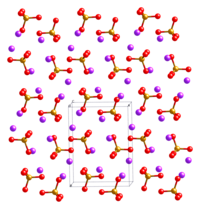Potassium ferrate
 |
|
 |
|
| Names | |
|---|---|
|
IUPAC name
Potassium ferrate(VI)
|
|
| Other names
Potassium ferrate
Dipotassium ferrate |
|
| Identifiers | |
| Properties | |
| K2FeO4 | |
| Molar mass | 198.0392 g/mol |
| Appearance | Dark purple solid |
| Density | 2.829 g/cm3, solid |
| Melting point | >198 °C (decomposition temp) |
| soluble in 1M KOH | |
| Solubility in other solvents | reacts with most solvents |
| Structure | |
| K2SO4 motif | |
| Tetrahedral | |
| 0 D | |
| Hazards | |
| Main hazards | oxidizer |
| R-phrases | 8 |
| S-phrases | 17-36 |
| Flash point | non-combustible |
| Related compounds | |
|
Other anions
|
K2MnO4 K2CrO4 K2RuO4 |
|
Other cations
|
BaFeO4 Na2FeO4 |
|
Except where otherwise noted, data are given for materials in their standard state (at 25 °C [77 °F], 100 kPa).
|
|
|
|
|
| Infobox references | |
Potassium ferrate is the chemical compound with the formula K2FeO4. This purple salt is paramagnetic, and is a rare example of an iron(VI) compound. In most of its compounds, iron has the oxidation state +2 or +3 (Fe2+ or Fe3+). Reflecting its high oxidation state, FeO42− is a powerful oxidizing agent.
Georg Ernst Stahl (1660 – 1734) first discovered that the residue formed by igniting a mixture of potassium nitrate (saltpetre) and iron powder dissolved in water to give a purple solution. Edmond Frémy (1814 – 1894) later discovered that fusion of potassium hydroxide and iron(III) oxide in air produced a compound that was soluble in water. The composition corresponded to that of potassium manganate. In the laboratory, K2FeO4 is prepared by oxidizing an alkaline solution of an iron(III) salt with concentrated chlorine bleach.
The salt is isostructural with K2MnO4, K2SO4, and K2CrO4. The solid consists of K+ and the tetrahedral FeO42− anion, with Fe-O distances of 1.66 Å. The poorly soluble barium salt, BaFeO4, is also known.
The main difficulty with the use of K2FeO4 is that it is often too reactive, as indicated by the fact that it decomposes in contact with water, especially in acidic water:
...
Wikipedia
